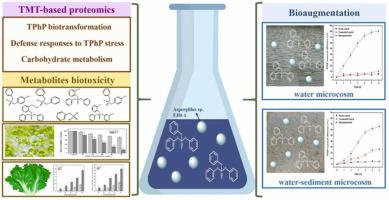Journal of Hazardous Materials ( IF 13.6 ) Pub Date : 2021-10-19 , DOI: 10.1016/j.jhazmat.2021.127545 Mi Feng 1 , Jiahua Zhou 2 , Xiaolong Yu 3 , Wei Mao 2 , Yushuo Guo 2 , Hao Wang 2

|
In this study, Aspergillus sydowii FJH-1 isolated from soil was verified to be a novel triphenyl phosphate (TPhP) degrader. Biodegradation efficiency of TPhP by Aspergillus sydowii FJH-1 exceeded 90% within 6 days under the optimal conditions (pH 4-9, 30℃, initial concentration less than 20 mg/L). Proteomics analysis uncovered the proteins perhaps involved in hydrolysis, hydroxylation, methylation and sulfonation of TPhP and the primary intracellular adaptive responses of Aspergillus sydowii FJH-1 to TPhP stress. The expression of carboxylic ester hydrolase along with several thioredoxin- and glutathione-dependent oxidoreductases were induced to withstand the toxicity of TPhP. The presence of TPhP also caused obvious upregulation of proteins concerned with glycolysis, pentose phosphate pathway and tricarboxylic acid cycle. Data from toxicological tests confirmed that the cytotoxicity and phytotoxicity of TPhP was effectively decreased after treatment with Aspergillus sydowii FJH-1. Additionally, bioaugmentation with Aspergillus sydowii FJH-1 was available for promoting TPhP removal in real water and water-sediment system. Collectively, the present study offered a deeper insight into the biodegradation mechanism and pathway of TPhP by a newly screened fungal strain Aspergillus sydowii FJH-1 and validated the feasibility of applying this novel degrader in the bioremediation of TPhP-polluted matrices.
中文翻译:

一种新型真菌分离物对磷酸三苯酯的生物降解机制及其在污染河流沉积物生物修复中的潜力的研究
在这项研究中,从土壤中分离出的Aspergillus sydowii FJH-1 被证实是一种新型磷酸三苯酯 (TPhP) 降解剂。在最佳条件下(pH 4-9, 30℃, 初始浓度小于20 mg/L) , Aspergillus sydowii FJH-1对TPhP的生物降解效率在6天内超过90%。 蛋白质组学分析揭示了可能参与 TPhP 的水解、羟基化、甲基化和磺化以及Aspergillus sydowii的主要细胞内适应性反应的蛋白质FJH-1 对 TPhP 的压力。羧酸酯水解酶以及几种硫氧还蛋白和谷胱甘肽依赖性氧化还原酶的表达被诱导以抵抗TPhP的毒性。TPhP 的存在还导致与糖酵解、磷酸戊糖途径和三羧酸循环有关的蛋白质明显上调。毒理学试验数据证实,用Aspergillus sydowii FJH-1处理后TPhP的细胞毒性和植物毒性得到有效降低。此外,Aspergillus sydowii FJH-1 的生物强化可用于促进真实水和水-沉积物系统中 TPhP 的去除。总的来说,本研究通过新筛选的真菌菌株对 TPhP 的生物降解机制和途径提供了更深入的了解。Aspergillus sydowii FJH-1 并验证了将这种新型降解剂应用于 TPhP 污染基质的生物修复的可行性。



























 京公网安备 11010802027423号
京公网安备 11010802027423号